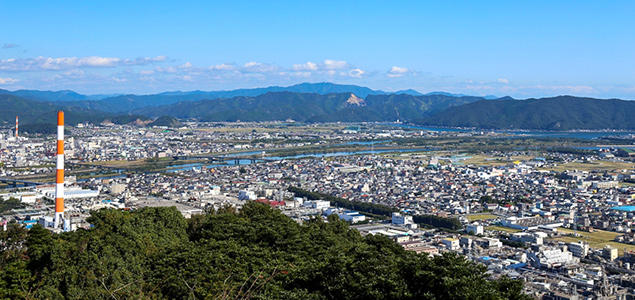本文
Firefly Q&A
Q1. What is a firefly?

A firefly is an insect belonging to the Trypoxylus dichotomus (Rhinoceros beetle) family. It has six legs and its body is divided into three parts: head, chest, and abdomen. Presently, approximately 3000 species of firefly are thought to exist around the world, with 44 of these species having been confirmed in Japan.
During its lifetime, the firefly changes from an egg to larva, then to a chrysalis and finally an adult, the stage that we are most familiar with. Around the world there are many different species of firefly with different appearances and characteristics. Some species grow as long as 8cm. In other species, males and females emit different light. And even some species of firefly never grow wings at all. It is expected that many new species will be discovered in the future. However, fireflies are threatened by serious global environmental damage and, while certain areas have taken rigorous measures to protect firefly populations, many species are becoming extinct.
Q2. Why are fireflies called 'hotaru' in Japanese?

The word 'hotaru' was first recorded in the Nihon-Shoki (the second oldest chronicles of classical Japanese history) in 720AD and was already known with the kanji「螢」 during the Heian Period (794-1185AD). Although there are many different explanations about the origin of the word ‘hotaru', there are two main theories.
The first explanation is that the 'ho' comes from the word for fire, 'hi', and the 'taru' comes from 'tare', meaning to hang down. Perhaps people thought that the firefly, when lit up, appeared to have fire hanging down from its body.
The second theory stems from the assumption that in the past people really believed that fireflies had fire flowing out from the tips of their tails, and referred to them as ‘hitaremushi', meaning fire-flowing insect. This was later shortened to ‘hitare', which over time changed to ‘hotaru'.
Although the origin of the word ‘hotaru' has fascinated historians for some time, it remains a mystery! Perhaps we'll never know exactly why they have been given this name!
Q3.What kind of life do the fireflies lead?
Each type of firefly tends to have a different lifestyle, depending on the environment they live in. For example, some fireflies live exclusively on land, whereas other types live underwater until the chrysalis stage. This article will discuss the life cycle of two types of fireflies – the Genji and Heike – which are native to Japan. There are regarded as unique around the world because they live underwater only for the larval stage.
| Genji Firefly | Heike Firefly | |
|---|---|---|
| Adult Stage | Adults appear starting in late May or early June and blink at a rate of about once every 4 seconds in Eastern Japan and once every 2 seconds in Western Japan. This mass of flickering, as males search for mates, is considered adaptive behavior. After mating, the female lays around 800-1200 eggs in the moss on the riverbank and then dies. |
Adults appear from mid-June to mid-July. Their illumination pattern is relatively slow-paced. Furthermore, one female may attract many males, forming a colony of light. After mating, the female lays around 50-100 eggs in the moss at the water's edge and then dies. |
| Egg Stage | The eggs are elliptical in shape and milky-white in color with a major axis of approximately 0.5mm. The eggs incubate for around a month. | The eggs are elliptical in shape and milky-white in color, with a major axis of approximately 0.5mm. The eggs incubate for around 20-30 days. |
| Larva Stage |
The larvae live underwater and feed on a kind of water snail called Semisulcospira libertine. The larvae must eat about 30 snails to grow to their mature state. They then repeatedly shed their skin, emerging onto land around April, where they make a cocoon in the mud on the riverbank. This becomes a chrysalis. |
The larvae live underwater, feeding on the snails found in paddy field, such as Radix auricularia japonica. Over time they have adapted to rice paddy farming techniques and are able to hibernate in the damp earth of the rice paddy. In May, they make a cocoon in the mud on the water's edge. This becomes a chrysalis. |
| Chrysalis Stage | Fireflies emit light even when inside the chrysalis. They emerge from the chrysalis after around 50 days. |
The firefly emerges from the chrysalis around 30 days later, and crawls above ground. |
Q4. What do fireflies eat?

Most types of fireflies must feed during their larval stage, but once they become adults they need only a small amount of water to survive. The larvae of the most famous firefly in Japan, the Genji firefly, feed on the snails Semisulcospira libertine that live underwater. The larvae of the Heike firefly, which live in rice paddies, irrigation channels and wetlands, feed on Viviparadae pond snails, Semisulcospira libertine snails and Radix auricularia japonica snails etc. Besides these, the terrestrial Hime (princess) firefly feeds on Allopeas clavulinum snails and Bekkochlamys perfragilis snails etc., and the Oba (old lady) firefly, which lives in the mountains and forests, feeds on small animals. We can say that fireflies have varying food sources based on their living environments.
Q5. Why do fireflies light up?

It is well known that there are many different varieties of firefly, from those that emit a weak continuous light to those emitting strong intermittent flashes of light. There are also some species that have light-emitting larvae, species that do not light up when fully mature, and species where the color of light emitted by the male and female differs. Furthermore, there are some types of firefly, like the Genji firefly, that light throughout their life from egg stage to adulthood.
Fireflies have different light-emitting devices and methods of lighting up that they use for different situations, depending on the purpose of the action. For example, it is thought that the reason why eggs, larvae and chrysalises light up is to warn away predators whereas adult fireflies light up to communicate with each other and search for a mate. Fireflies that do not light up are suited to conducting their activities during the day, and so they use smells as signals instead.
Q6. How do fireflies light up?

Firstly, the parts that emit the light in fireflies include the reflective layer, epithelium, light-emitting cells, the trachea and neurons. A complicated oxidation reaction occurs in these light-emitting cells between a substance called luciferin and an enzyme called luciferase, as well as adenosine triphosphate (which is characteristic to all living creatures, known as ATP), a miniscule amount of magnesium and some oxygen.
Usually, oxidation reactions produce heat, but in the case of the fireflies, light is produced instead of heat. The light emitted from the light-emitting cells is reflected by the reflective layer, and shines through the transparent epithelium to the outside world.
This is a simple explanation of how fireflies emit light. The light emitted by the firefly is not always constant; it may flicker or shine on and off. Because the process of emitting light is extremely complicated, the reason behind the inconsistency of the firefly's light is not yet fully understood.
Q7. When is a good time to see the fireflies?

The activity of the fireflies is most vigorous at three different points during the day: 7:30-9p.m., around midnight, and finally around 2a.m., so the best time to watch them is probably between 7:30 and 9p.m. As it starts to get dark just after 7p.m. you'll begin to see the odd light here and there, and then you'll start to see light as though they are gathering into a big group. This simultaneous flickering in a group setting is a trait of the Genji firefly. The peak of light activity is around 8:30pm and from the period after 9p.m. if they have found a mate, you can also see fireflies stopping on the grass and entering the mating period. Since fireflies are sensitive to light and sound, it is advised to watch them quietly.
Q8. Are there any links between the appearance of fireflies and the weather?

The best time to see fireflies is on a warm dark night with no wind and no moonlight. When the wind is strong or the temperature is low they hide in the trees and bushes and keep still. Fireflies tend to prefer dark places and avoid areas with artificial light. On rainy days, there is a sharp decline in numbers.
Q9. What kind of environment is necessary for fireflies to thrive?

While the presence of large numbers of fireflies can tell us what kind of environments are conducive to their growth and reproduction, the ideal environment differs based on the specific characteristics of each species. In simple terms, terrestrial fireflies require woods, forests and fields, etc., while aquatic fireflies seek out rivers, paddy fields and irrigation channels, etc. Let us examine the case of the rare aquatic Genji firefly in order to understand the specific environmental needs of a single species.
The first condition is the presence of overgrown trees and grasses on the riverbank and water's edge, where the fireflies can lay their eggs. A preserved natural area undisturbed by humans is ideal. The second condition is that the water must be unpolluted, providing a good nutritional balance and a place where the larvae's food source, Semisulcospira libertine, can grow. The water must also flow consistently all year round, even throughout the winter. The third condition is the presence of an embankment or sandy area where the larvae can go underground, once they move onto land. The fourth condition is that the water's edge, where the fireflies flutter around, is a dark place where there is very little artificial light from car headlights or streetlights etc.
Q10. How can I learn more about fireflies?

You can search in the library or ask someone who knows a lot about fireflies, but if you have time, please come to Kitagawa! There is a museum and resource library called 'Firefly House' in Kitagawa town where you can learn about fireflies and their habitat in great detail. There are rare images and materials on display, and fireflies are bred inside the building. Furthermore, if you speak to the manager, Mr. Jikumaru, I'm sure he will tell you many interesting things about fireflies.





